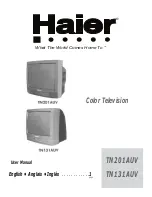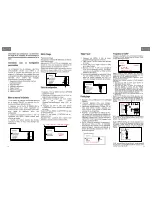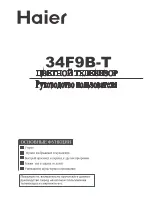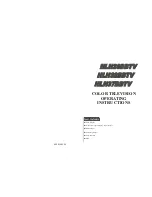
CUC 7301
GRUNDIG Service
2 - 5
Schaltungsbeschreibung / Circuit Description
Über Transistor CT110 und IC2807 (Option)) steht es als FBAS
SC
am
Videotext-Decoder IC2810-(8) und über die Transistoren CT963,
CT962 an der Scartbuchse Pin 19.
Als FBAS
steht es am Signalquellenumschalter IC150-(13).
Der zweite Eingang des Signalquellenumschalters Pin 15 ist mit der
Scartbuchse Pin 20 verbunden.
Der Prozessor IC850-(12), Spannung U
VQ
, Transistor CT840 trifft an
IC150-(16) die Auswahl, ob das Signal vom Tuner oder von extern
verarbeitet werden soll.
3.4 Externes FBAS-Signal
Am Signalquellenumschalter IC150-(15) steht entweder ein externes
FBAS-Signal von der Scart-Buchse oder das HF-FBAS-Signal. Die
Spannung U
VQ
an IC150-(16) wählt aus, ob das FBAS-Signal der
Scart-Buchse, oder das HF-FBAS-Signal weitergeleitet werden soll.
IC150-(16) "Low" internes -, IC150-(16)"High" externes Signal.
Achtung: Ist die "Decoder Ein" Kennung gesetzt, erwartet das Gerät
ein Signal von der Scart-Buchse. Das FBAS-Signal vom Tuner ist aber
am Ausgang Pin 19 der Scartbuchse meßbar.
3.5 Ton-ZF
Dem Tonsignal ist nach dem Keramikfilter F926 an IC150-(5) eine
Gleich- spannung zur Einstellung der Lautstärke unterlegt. Die
Demodulation erfolgt in einem PLL Demodulator.
Einmal wird das demodulierte und ungeregelte NF Signal an IC150-(1)
ausgekoppelt, von den Transistoren CT917, CT916 verstärkt und zur
Scart-Buchse geleitet.
Zum anderen steht das demodulierte und geregelte NF-Signal an
IC150-(50) und gelangt zum NF-IC TDA 7233.
3.6 Luminanz- und Chrominanz-Signal
Die Kalibrierung und Regelung erfolgt automatisch während der
Bildaustastlücke. Eine Änderung der Einstellung resultiert aus einem
positiven oder negativen Strom in den Integrationskondensator CC177
an IC150-(12). Während des sichtbaren Teils wird die Regelung
geklemmt.
Das Luminanzsignal durchläuft den im IC integrierten Farb-Trap. Eine
im IC eingebaute Verzögerungsleitung kompensiert die Laufzeitunter-
schiede zwischen Luminanz- und Chrominanzsignal. Die anschlie-
ßende Verbesserung der Kantenschärfe (Peaking) wird ebenfalls im
IC realisiert. Dabei werden die ansteigenden und abfallenden Flanken
des Y-Signals versteilert. Im internen Farbfilter wird das Chrominanz-
signal aus dem FBAS-Signal herausgefiltert. In einem Regelkreis wird
die Amplitude des Farbsignals für den Farblimiter und die Farbregelung
kontrolliert und gelangt als Chromasignal auf den Farbdemodulator.
Aus dem Chromasignal wird der Burst herausgelöst, der den
Via the transistor CT110 and IC2807 (optionally) it is fed through to the
videotext decoder IC2810-(8) as FBAS
SC
signal, and via the transistors
CT963, CT962 it is supplied to the Scart socket pin 19.
At the signal source switch IC150-(13), the signal is present as FBAS.
The second input of the signal source switch Pin 15 is connected to the
Scart socket pin 20.
At IC150-(16), the processor IC850-(12), voltage U
VQ
, transistor CT840
decides as to whether the signal from the tuner or the external signal
is processed.
3.4 External CCVS Signal
At the signal source switch IC150-(15) either an external CCVS signal
from the Scart socket or the HF-CCVS signal is present. The voltage
U
VQ
at IC150-(16) decides which signal shall be passed on, the CCVS
signal from the Scart socket or else the HF-CCVS signal. IC150-(16)
"Low", the internal signal is selected; IC150-(16) "High", the external
signal is passed on.
Attention: If the option "Decoder On" has been selected the TV
expects the signal to come from the Scart socket. However the CCVS
signal from the tuner can be measured at output Pin 19 of the Scart
socket.
3.5 Sound IF
After the ceramic filter F926, the sound signal is superimposed at
IC150-(5) on a direct voltage for setting the volume level. Demodula-
tion is effected by a PLL demodulator.
In one path, the demodulated and uncontrolled AF signal is fed out at
IC150-(1), it is then amplified by the transistors CT917, CT916 and
passed on to the Scart socket.
In another path, the demodulated and controlled AF signal is present
at IC150-(50) and is fed to the AF-IC TDA 7233.
3.6 Luminance and Chrominance Signal
Calibration and control is effected automatically during the frame
blanking period. The signals are adjusted by a positive or negative
current entering the integration capacitor CC177 at IC150-(12). During
the scanning period the control voltage is clamped.
The luminance signal passes though the colour trap integrated in the
IC. The delay line provided in the IC is used to correct delay time
differences between the luminance and chrominance signal. The
colour transient improvement (peaking) which follows is also realized
in this IC. For this, the steepness of the leading and trailing edges of
the Y-signal is improved. The internal chroma filter separates the
chrominance signal from the CCVS signal. A control circuit adjusts the
amplitude of the colour signal for the chroma limiter and chroma
control. The resulting chroma signal is passed on to the colour
demodulator. From this chroma signal, the burst is separated which is
used to synchronise the colour oscillator in phase and frequency. The
Bild ZF und Demodulation
Vision IF and Demodulation
FBAS und Ton
Ausgang
CCVS and Sound
Output
F130
ZF vom Tuner
IF from Tuner
U
für denTuner
for the Tuner
URV
vom Prozessor
from Processor
AFC
Koinzidenz
Coincidence
Sync
Detector
TDA8362A
~
45
46
2
3
47
49
9
4
7
~
















































